Pierpaolo Piccioli on How His Atelier, and Family, Make Valentino What It Is

After working at Fendi for almost 10 years, Pierpaolo Piccioli joined Valentino as an accessories designer in 1999. Now, 21 years later, as the sole creative director of the house (following the departure of Maria Grazia Chiuri to Dior in 2016), he has produced some of the most sublime couture and imagery in Valentino’s glittering history. If you are lucky enough to attend a Maison Valentino couture show at Paris’s grand Hôtel Salomon de Rothschild, the odds are good that you will be moved to tears. While each garment is imagined by Piccioli, what makes each collection special is its palpable heart: a combination of Piccioli’s vision and that of his beloved team, who create everything by hand. The members of Valentino’s atelier not only own what they do but also are routinely celebrated, appearing on Piccioli’s Instagram (often with their own soundtrack).
A true couturier, Piccioli is also a true Roman who walks the city (or steps out of restaurants for a cigarette) in his mostly black VLTN Ts and sneakers. When he finishes his work in the studio, he jumps into a car to go home to Nettuno, an unpretentious beachside suburb where he was raised and now lives with his wife, Simona; his three children, Benedetta, Pietro, and Stella; and their dog, Miranda (named after Priestly, of course).
VIDEO: When In Roma
We meet for lunch at Nino, a restaurant a few blocks away from Valentino’s storied headquarters on Piazza Mignanelli, near the Spanish Steps. On the way to our table, Piccioli is stopped by Federico Forquet, a Roman couturier — and Balenciaga protégé — who was active in the 1960s and early 1970s. Now nearing 90, the gracious and elegant Forquet tells Piccioli sincerely that he’d given up on fashion but the designer’s work for Valentino has “reinspired” him. Piccioli smiles widely, says “Grazie mille,” and bounds over to our table.
This sort of interaction is not unusual. Piccioli is routinely stopped by fans and mobbed backstage after his presentations. But he’s not grand. He isn’t humble (an often disingenuous word in fashion) either. Piccioli knows his abilities and knows how to deploy them, with care, craft, and a lack of pretension. And that’s why he is doing something more resonant than creating even the most glorious couture: He’s changing the culture of fashion.
LAURA BROWN: So, Pierpaolo, Federico Forquet just told you that you’ve reinvigorated his love of fashion. He’s not the only one who feels that way.
PIERPAOLO PICCIOLI: He left fashion many years ago because he lost interest in it. So now he told me, “I got emotional from your shows. And because of you, I found the enthusiasm in fashion again.” That’s the best part of what I do. To have someone not just say, “Your work is beautiful,” but to be involved in your dream and share the same idea that fashion is magical, and not just marketing, is so personal. And, of course [laughs], I invited him to the next show.
LB: But you’ve been doing this for a long time. You’ve been at Valentino for years and have always approached fashion with complete optimism. It’s like you’ve peeled away at people’s cold, dead hearts.
PP: I never imagined I’d have all of this in my life. I grew up by the seaside, far from fashion, cinema, red carpets, shows in Paris, everything. So to be here every day is something I appreciate as a gift of life. I could say that there’s a pressure to do multiple shows, men’s and couture. But I don’t feel that pressure. When I have problems, I face them like everybody else.
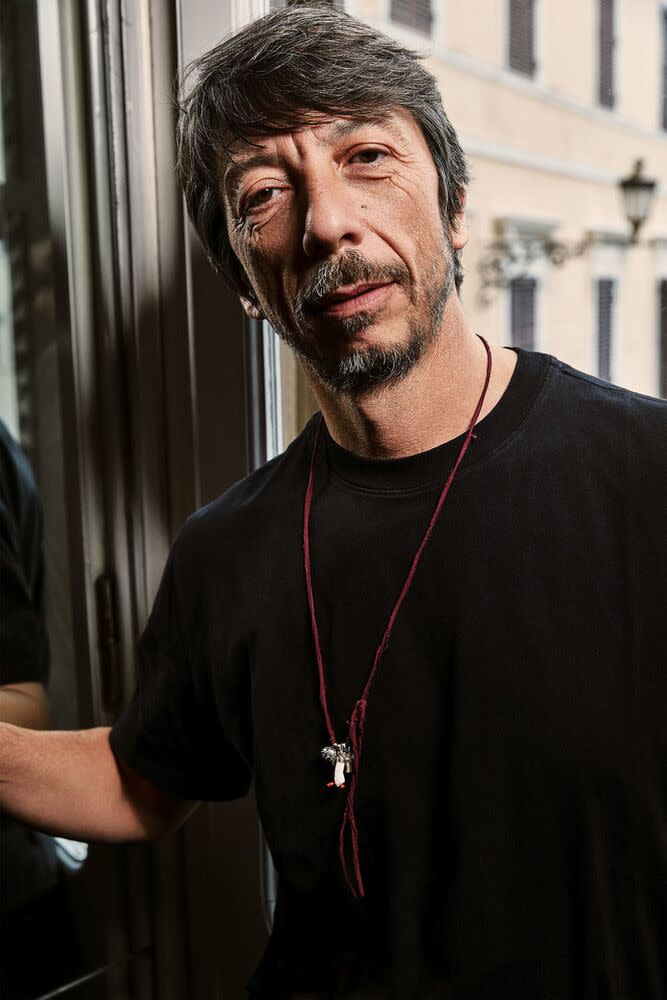
Piccioli in a Valentino T-shirt and a Valentino Garavani necklace. Photography: Franco Pagetti
LB: It’s not the worst job in the world.
PP: Exactly. I take the fashion very seriously, but I don’t take myself so seriously. I don’t like the cliché of the designer alone in his room with a canvas and flowers, taking inspiration from the massive painting he has on the wall. I get inspiration from people much more than from any masterpiece in the world.
LB: Fashion, in so many ways, is predicated on this exclusionary idea of “This thing is cool, versus that thing.” What I’ve always loved about you is that you actually say before a show that you’re excited for it.
PP: I never planned to be a creative director. It just sort of happened. I do remember, right after I got this position, I had the feeling that maybe it was better to act “cool.” But then I realized that if I arrived here because of how I am, then I should stay like that. I’ve already had much more than I ever expected to have in my life. So, who cares? Tomorrow I can stop and do something else.
LB: It’s such a relief to get to that point, isn’t it? When you see people acting “cool,” what do you think?
PP: When you’re not trying too hard, people are more relaxed around you. That’s why I have friends in fashion. I’m not competitive with them. I respect people who have an identity because then you don’t need to play a role.
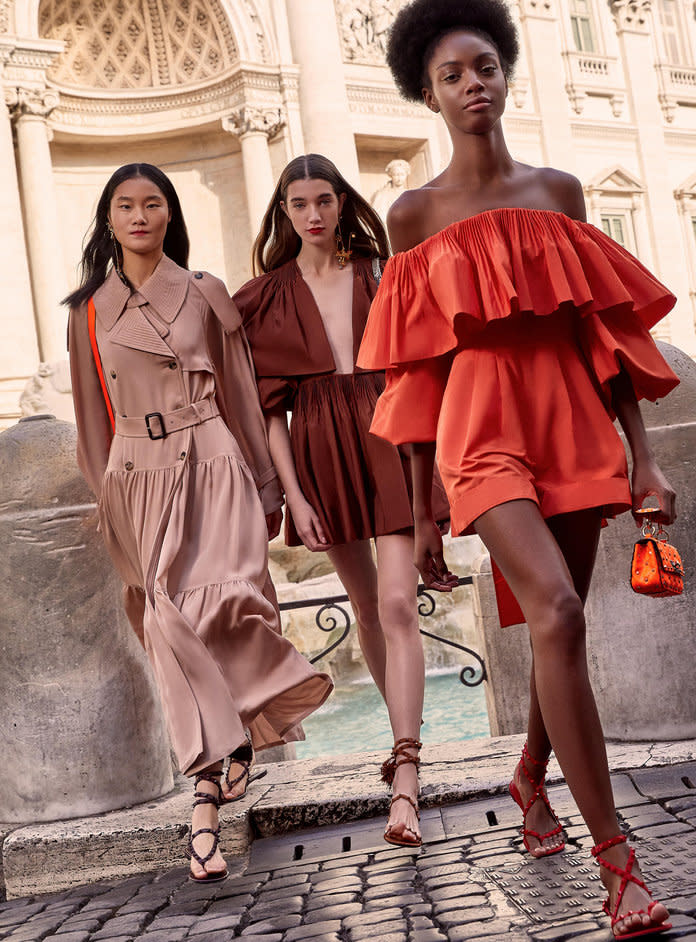
All clothing, Valentino. All accessories, Valentino Garavani. Photography: Franco Pagetti
LB: Sometimes when I come up against that old-fashioned behavior, I get so frustrated. What movie do people think they’re in? But you and I aren’t that typical. [laughs]
PP: It’s fine to not be typical. I’m proud of it! It’s more about what you do that is relevant. My job is an expression of who I am and the values I believe in. You can see through my shows that freedom is important, that diversity is beautiful. That’s how I can be relevant.
LB: When you see something that you just sketched one day actually materialize, how does that feel?
PP: An old Italian cinema critic once said to me, “You draw like artists do, copying reality.” In some way, it’s true, because when I draw, I have something in my mind that I have to make. And the sketch is only good if it’s exactly the same as what I have in my mind.
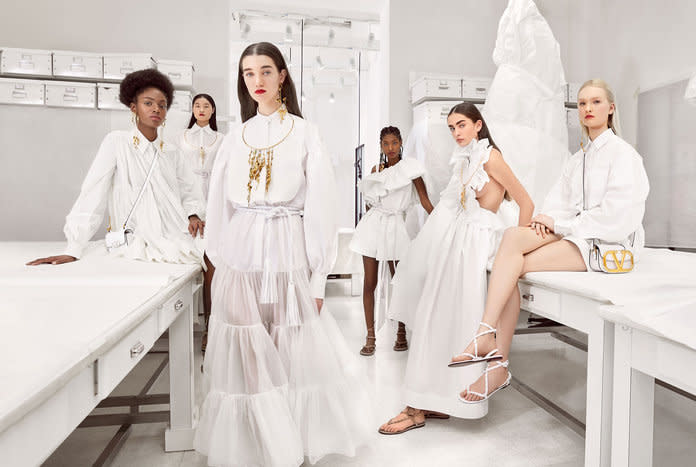
All clothing, Valentino. All accessories, Valentino Garavani. Photography: Franco Pagetti
LB: And it’s not a power thing.
PP: Not at all. When I see something beautiful, I don’t say to the seamstresses, “You need to make it a little shorter so it feels more like mine.” It’s already mine. And I prefer it when other people are part of the journey. When I share with them what I have in my mind, in the end, they give so much more. They put passion, love, and care back into it.
LB: Sometimes designers will bring the team from their studio onstage, but you were the first one to go out there on Instagram and say, “Here is my seamstress with her dress.” I don’t see other designers going into their atelier and shining a light like that.
PP: I think that you have to involve people. If not, you’re alone and what you deliver is not warm. It’s good, maybe, but it’s not desirable, because desirability comes from people’s feelings. For our last couture show in July I didn’t plan to bring out the seamstresses. But when I saw that people were emotional and there was a magical atmosphere, I decided to bring all of them out. I’m not on this journey alone. And they worked hard for months, so it was important for them to feel that joy too.
LB: Who in the atelier is the biggest ham on your Instagram?
PP: Actually, there are five or six of them who are the queens or kings. [laughs] But now after shooting the feather-hats story [for A Magazine Curated By], some of them were like, “Why didn’t you choose me?”
LB: What a funny way to encounter office politics, via a pink feather hat!
PP: If I had the opportunity, I would include all of them. I want everyone I work with to feel involved because I want to be around people who are sincere enough to say, “I don’t like this.” I don’t want to always be pleased. I repeat to myself every day that my job is to project the idea of beauty in the time I’m living in. And if I don’t relate to reality, to people, to what’s happening in the world, then I’m only doing half of my work.
LB: And you can smell bullshit too.
PP: In my early days at Valentino someone asked me, “What do you think of this jacket?” Of course, I was supposed to say, “This is fantastic.” But instead, I said, “This is beautiful, but maybe it will be better with a pair of jeans.” And people were like…dun, dun, dun. [laughs] Like I could’ve been fired for saying it.
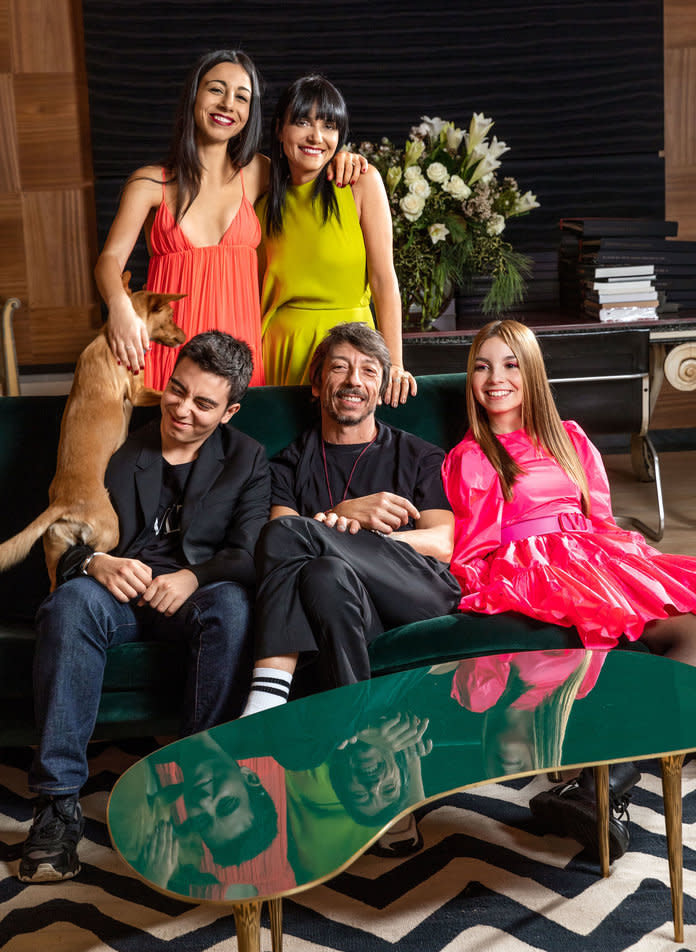
The Piccioli family, clockwise from top left: Benedetta, Simona, Stella, Pierpaolo, and Pietro, with their dog, Miranda. All clothing, Valentino. All accessories, Valentino Garavani. Photography: Franco Pagetti
LB: Have you always been secure in your taste and your ability to speak up?
PP: I’ve always been confident in saying what I am thinking. That’s probably why I work well with young people. I like to hear from them because I want to give back what I had in my life. I remember going to Paris for the first time to [the trade show] Première Vision, and there were these big rooms full of fabric that I was wowed by. But all of the very cool fashion people said, “There’s nothing. You can’t find anything in here.” At first I thought, “Oh, fuck. They have something fantastic in their mind, and I can’t see it.” But then I understood that it was just bullshit, because you could do an amazing collection with half of the things in that room. It’s about talent — it’s not about fabrics. When I was young, it was enchanting to see all of this. That made me different from other people.
LB: There’s nothing cooler than enthusiasm.
PP: To look better, people tend to act like they’re not impressed. I never hide my amazement. It’s like when I saw a Picasso for the first time in someone’s home, I thought, “Wow, fuck. Picasso. I was in line yesterday to see one in the museum.” But everyone else just looked and said, “OK, nice,” because it was cooler. Then someone said, “Oh, well, I actually collect Chinese boxes.” And I thought, “Really? You feel the need to elevate yourself to ‘I collect Chinese boxes’?” [laughs]
LB: Aha! I don’t see any Chinese boxes here.
PP: I may have this fantastic office now, but I am the same. I’m not changing just because the faces are changing around me. People tell me I’m humble, but I’m aware of what I do in fashion. I feel lucky to be able to express my vision of beauty, but I don’t feel like it’s better to be modest. I’ve been given the opportunity to show my talent, and the talent of people who work with me.
RELATED: Julia Louis-Dreyfus Clears the Air
LB: Some people don’t like the word “pride” because they think it has ego in it. But why can’t you say, “I can do it, I’m good at it, and I’m a good person.”
PP: I want to show that you can be yourself and faithful to your dreams, but you also need to have talent. You need to work hard. You don’t just win the lottery. I’ve been working for 30 years at this. For me, this is a passion. It’s not a job.
LB: My favorite picture in this story, apart from the one of your family, is the shot of the models in the Le Blanc line in the atelier.
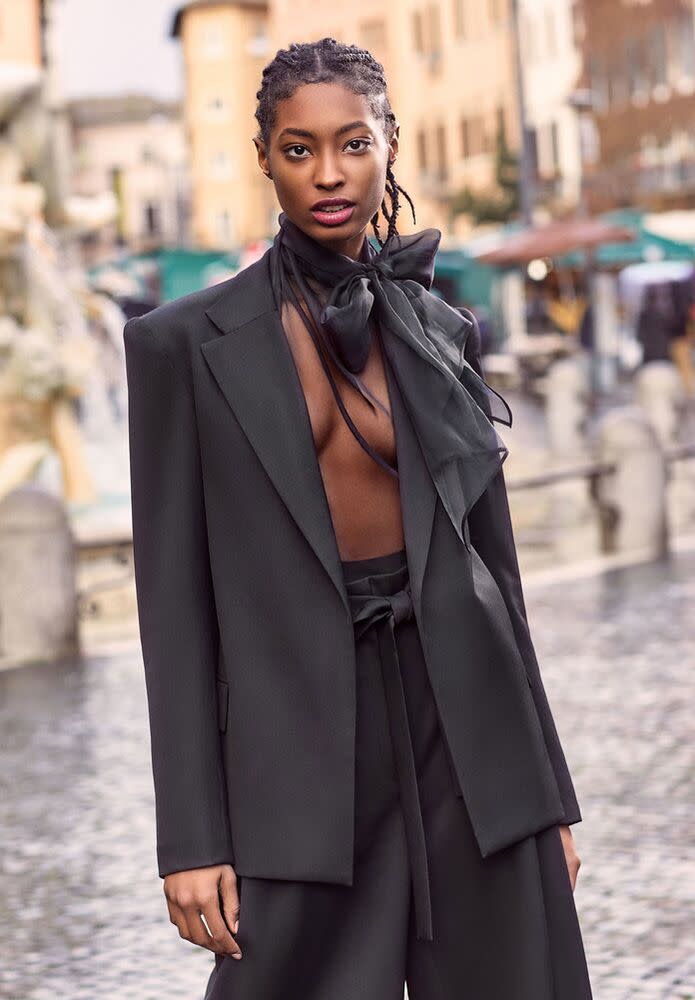
All clothing, Valentino. All accessories, Valentino Garavani. Photography: Franco Pagetti
PP: Well, Valentino is a couture house, and that means that the culture, the care, the individualism of couture has to be infused into every category — in the bags, in the shoes, in the ready-to-wear. Le Blanc takes a white shirt, which is probably the most democratic piece, and makes it couture by adding volume. It keeps the authenticity but changes the attitude with the ruffles and the fit. I’m working to make the white shirt, the most universal piece, into the most individual one.
LB: It came out so beautifully.
PP: It’s always nice when you start with couture and arrive in the streets. Because when you think of couture, you imagine a beautiful, super-dusty picture from the past. But couture can be relevant if it’s part of the world today. For the campaign I cast 10 women, but they’re not all models like Adut [Akech]. Of course, seeing her embody Roman beauty means a lot, but I wanted to include women with all different kinds of attitudes.
LB: You’ve been with your wife, Simona, for a long time. How has your family experienced your success?
PP: You need to have someone who totally supports you. And with Simona I never had to choose between my career and my family. With my friends it’s the same. As a designer, having people like Simona and my children beside me who are totally sincere, if not critical, with me is the best. I have the perfect person to consult with because my 13-year-old daughter, Stella, will tell me what she is thinking. [laughs]
LB: Yes, well, that’s exactly what she should be doing.
PP: Simona asked me once, “How do I look in this dress?” I said, “Hmm.” And she said, “With me, you have to be a husband and not a designer, so even if you don’t like it, you have to say, ‘It’s beautiful.’” [laughs] But with my family I feel free to follow my dreams everywhere because I’ll never get lost. I’ll always have a place to go back to.
Photography: Franco Pagetti. Styling: Konca Aykan. Hair: Giulio Ordonselli. Makeup: Gianluca Ferraro for Etoile Management. Manicure: Isabella Avenali. Models: Makala Johnson for Women 360 Management; Laurina Lubino for Makers by Metropolitan; Alisha Nesvat for The Fabbrica; Isa Peerdeman for Ford Models; Natalia Trnkova for Women Management; Canlan Wang for Women 360 Management. Casting: Olivier Duperrin. Production: Amazed By.
For more stories like this, pick up the March issue of InStyle available on newsstands, on Amazon, and for digital download Feb. 14.

